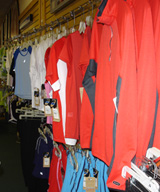
 |
||||||
|
Apparel As you choose your line of running apparel, you first have to pick the right fabric, or more specifically the fabric that wicks moisture away from your body. “Wicking” is the fabric’s inclination to pull moisture from your body and evaporate quickly, which keeps you dry. If you are looking at natural fabrics, which are rare in running stores, you want to look for wool. Wool is great because it keeps you warm and dry. You’ll find wool in some sock lines, but rarely in shirts, jackets, shorts, or pants. A good rule of thumb is to stay away from cotton. Cotton is an excellent material: it’s soft, it’s durable, it’s warm (when dry), and it’s relatively cheap. For a runner, however, cotton can be a nightmare. Cotton does not have the moisture managing capabilities found in other materials. When it gets wet, it becomes supersaturated and retains all the moisture your body is producing (this ability to retain moisture is why towels are made from cotton). When cotton is supersaturated, it has the effect on your skin that lying in a bath tub does—you become prune-like. This is bad because when you add heat and movement to your already sensitive skin, the likelihood of blistering, chafing, or callusing is very high. When selecting apparel, avoid “cotton rich” clothing. A good compromise would be 50% cotton and 50% polyester, but in general, the higher the polyester content the better. Polyester may have a bad rap, but for the runner it is the fabric of choice. There are plenty of advantages to polyester. It’s light, durable, smooth against the skin, and has tremendous moisture managing properties. It keeps you dry, and keeps you from chafing and blistering. Polyester is a very light and thin material, so it can be molded and fit into many types of clothing. It can be a light singlet or a t-shirt as easily as it can be included in a heavy winter “shell” jacket. Due to polyester’s great moisture managing properties it will keep you dry, which keeps you cooler in the summer and warmer in the winter—all without those pesky skin abrasions. |
|||||
 |
||||||
© Marathon Sports • 50th and Penn, Minneapolis, Minnesota • 612.920.2606